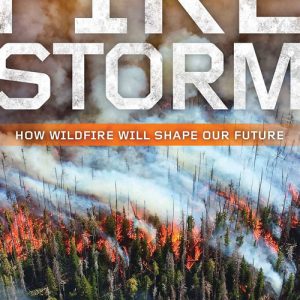
by Edward Struzik
ISLAND PRESS
2017/$30.00/272 pp.
The 2016 Fort McMurray wildfire was the costliest natural disaster in Canadian history. It destroyed some 2,000 residential and commercial buildings, sent 88,000 people fleeing from their homes and burned an area larger than Prince Edward Island. The $3.6-billion in insurance losses exceeded the Province of Alberta’s investment in its roads and bridges in 2017. And according to Edward Struzik’s Firestorm: How Wildfire Will Shape Our Future, this disaster was not an anomaly; it was a preview of things to come.
Firestorm paints a comprehensive picture of the changes taking place in the boreal forest and how wildfires are reshaping Alberta. “As we gradually became very good at fighting fires,” posits Struzik, “we created an unnaturally large amount of mature forests that made them increasingly vulnerable to insects, disease and wildfire.” Thanks to decades of fire suppression, and hotter, drier climates, our forests are poised to burn. “On average, more than seven thousand wildfires burn in Canada each year. The area burned has doubled since the 1970s, when global temperatures began to rise in earnest,” writes Struzik. “As the climate continues to warm … the area burned is likely to double again by the middle of the twenty-first century.”
Drawing on more than 30 years of newspaper and magazine reporting on environmental issues, Edmonton-based Struzik masterfully weaves together interviews with dozens of wildfire researchers and management experts. In Banff, for example, Parks Canada veterans tour Struzik through the town’s fire evacuation plans. They eye the forest on the west side of nearby Sulphur Mountain with apprehension because the forest hasn’t burned since 1889. When it does burn, the mature, less fire-resistant trees could fuel a megafire. From the gondola lookout at the top of Sulphur Mountain, Struzik worries that tourists “would be sitting ducks if a fire were to race up this precipice.” As Parks Canada’s Cliff White puts it, “Being upwind of the townsite, Sulphur Mountain would be like a volcano erupting … trees, fences and rooftops would begin to catch fire.”
Banff’s fire-prone state is a recent development, writes Struzik, noting that 100-year-old pictures reveal the national park looked more like a savannah than the lush, dense and combustible forests of today. Historically, “North American native tribes started fires to attract game, enhance berry growth, facilitate travel and communicate with other tribes.” In doing so, they “shaped the forest landscape with the fires they lit” and made the landscape more resilient to wildfire. Citing White, Struzik concludes that today the park “may look nice to tourists, but it challenges all of the definitions of what is natural.”
The next Fort McMurray-style wildfire could be in Banff, or Jasper, Prince George, Whistler or Victoria. Fires in any of these communities would devastate the local ecosystem and bring untold economic and human losses. But their impacts could also be felt farther afield, since “the vast majority of people in Canada and the United States … depend on forest watersheds for their drinking water.” On an even broader global scale, “smoke from [a fire in Yellowknife] affected air quality in New York and Chicago, and ash from that fire blackened some parts of the Greenland ice cap.”
Wildfires in the boreal forest affect us all. “Fort McMurray was in many ways a bellwether of what to expect in the future as the climate warms and dries out the northern forests and as more people live, work and recreate in them,” concludes Struzik. Firestorm interprets this bellwether with skill and alarm.
—Annie Prud’homme-Généreux is vice-president of science at TELUS World of Science in Edmonton.
_______________________________________
Click here to sign up for our free online newsletter.

